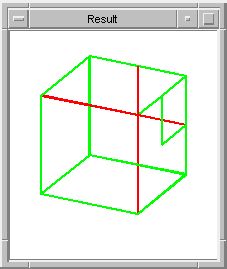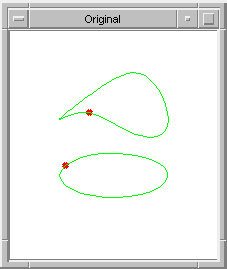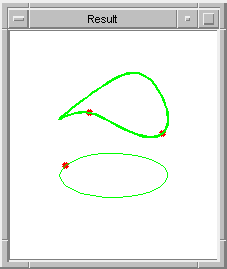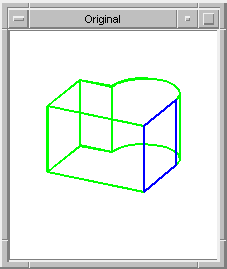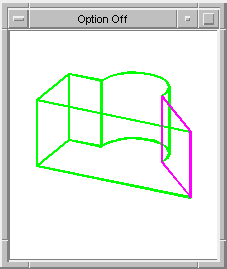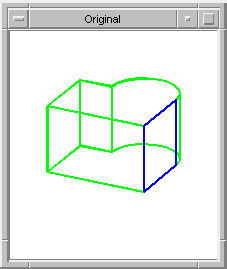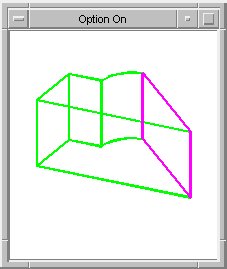Options |
|
|
|
Technical Article |
| Options may be set to modify the behavior of ACIS. An option's value
may be a flag (indicating an on/off state), a number (integer or real
number), or a string. Options may be set in a Scheme application (such
as Scheme AIDE)using the Scheme extension
option:set;
or in a C++ application
using one of several API functions.
|
extend_mergeable_edges
- Action
-
Controls whether or not mergeable edges are extended.
Name String-
extend_mergeable_edges
Scheme-
| Type |
Values |
Default |
| boolean |
#f,#t |
#t |
C++-
| Type |
Values |
Default |
| logical |
FALSE,TRUE |
TRUE |
Description
This option is used when mergeable edges have a NO_MERGE_ATTRIB
attribute attached. Certain local operations honor these attributes. When
the face on which such a mergeable edge lies grows in size, the user has
a choice as to whether the mergeable edge should be extended to the boundary
of the face (if the option is on)or retain its original size (if the option
is off). Retaining its original size could result in edges that were connected
to the boundary of the face before the local operation now becoming disconnected
from the boundary.
Not all local operations honor the NO_MERGE_ATTRIB
attribute. Those that do include: move faces, offset faces, offset body,
sheet thickening (implemented in the Shelling Component), and shelling
(implemented in the Shelling Component).
[Top]
lop_check_invert
- Action
-
Controls the checking of invalid faces made in LOP.
Name String-
lop_check_invert
Scheme-
| Type |
Values |
Default |
| boolean |
#f,#t |
#t |
C++-
| Type |
Values |
Default |
| logical |
FALSE,TRUE |
TRUE |
Description
When this option is on, LOP checks faces and prevents invalid (inverted
or inside-out)body faces from being made. If this option is off, body
faces may be made and subsequently repaired using the Repair Body Intersections
Component.
; lop_check_invert
; Allow inverted face, then repair body
(define b1 (solid:block
(position -25 -25 -25) (position 25 25 25)))
;; b1
(define b2 (solid:cylinder (position 0 0 0)
(position 0 0 50)10))
;; b2
(solid:subtract b1 b2)
;; #[entity 2 1]
(render)
;; ()
; Pull hole out of block into a boss, switch off
; lop_invert_checking so invalid inverted body face
; can be made
(option:set "lop_check_invert" #f)
;; #t
(lop:offset-faces (pick:face (ray
(position 0 0 0) (gvector 0 0 1))) 50)
;; #[entity 2 1]
; Now repair the body
(rbi:rep-self-int b1)
;; #[entity 2 1]
(render)
;; ()
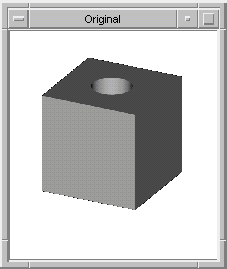  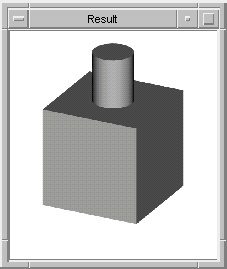
Figure. lop_check_invert |
[Top]
lop_convert_pipe
- Action
-
Sets conversion of pipe spline surface.
Name String-
lop_convert_pipe
Scheme-
| Type |
Values |
Default |
| boolean |
#f,#t |
#t |
C++-
| Type |
Values |
Default |
| logical |
FALSE,TRUE |
TRUE |
Description
When this option is on, LOP converts pipe spline surfaces to rolling ball
blend spline surfaces. This allows selected faces and their neighboring
faces to be extended.
; lop_convert_pipe
; Turn off lop_convert_pipe
(option:set "lop_convert_pipe" #f)
;; #t |
[Top]
lop_fail_on_no_part_inv_sf
- Action
-
Controls whether or not a local operation fails when a face surface
can only be partially offset.
Name String-
lop_fail_on_no_part_inv_sf
Scheme-
| Type |
Values |
Default |
| boolean |
#f,#t |
#f |
C++-
| Type |
Values |
Default |
| logical |
FALSE,TRUE |
FALSE |
Description
When a face surface can only be partially offset, the geometry returns
no surface at all. When this option is set to off, the local operation
continues by removing the face. However, this may lead to shells that
are too thin or have holes. This can be prevented by switching the option
on, in which case the local operation will fail instead of removing the
face.
; lop_fail_on_no_part_inv_sf
; Do a partial offset with the option on
(define b1 (solid:block (position -25 -25 -25)
(position 25 25 25)))
;; b1
(define edge1 (pick:edge (ray (position 0 0 0)
(gvector 1 0 1))))
;; edge1
(define rad1 (abl:two-ends-rad 10 1))
;; rad1
(abl:edge-blend edge1 rad1)
;; #[entity 3 1]
(blend:network edge1)
;; #[entity 2 1]
; Offset body so blend face surface partially inverts
; Presently no face surface is made but we must not
; remove the face, so switch on the option.
(option:set "lop_fail_on_no_part_inv_sf" #t)
;; #f
(lop:offset-body b1 -4)
;; Returned edge has been highlighted.
;; *** Error lop:offset-body: no solution for an edge |
[Top]
lop_ff_int
- Action
-
Sets additional validity checking of the body.
Name String-
lop_ff_int
Scheme-
| Type |
Values |
Default |
| boolean |
#f,#t |
#f |
C++-
| Type |
Values |
Default |
| logical |
FALSE,TRUE |
FALSE |
Description
Enables additional validity checking of the body after an API call in LOP,
SHL, or REM when turned on. The extra checks performed are:
Checks for improper face/face intersections.
Checks for improper shell containment between
two shells in the same lump.
Checks for improper lump containment (i.e. one
lump containing another).
If any problems are found, the local operation rolls the body back to
its original state.
These checks are not performed when this option is FALSE.
; lop_ff_int
; Create some geometry
(define b1 (solid:block (position 0 -10 -10)
(position 10 10 10)))
;; b1
(define b2 (solid:block (position 15 -10 -10)
(position 25 10 10)))
;; b2
(bool:unite b1 b2)
;; #[entity 2 1]
; Switch the option on.
(option:set "lop_ff_int" #t)
;; #f
; Try to make an invalid body
(lop:move-faces (car (pick:face (ray (position 5 0 0)
(gvector 1 0 0)))) (gvector 10 0 0))
;; entid -58248 entid -55072: Error: face
;; intersection
;; entid -58248 entid -55312: Error: face
;; intersection
;; entid -58248 entid -55552: Error: face
;; intersection
;; entid -58248 entid -56040: Error: face
;; intersection
;; entid -57528 entid -55072: Error: face
;; intersection
;; entid -57528 entid -55312: Error: face
;; intersection
;; entid -57528 entid -55552: Error: face
;; intersection
;; entid -57528 entid -55800: Error: face
;; intersection
;; entid -57288 entid -55312: Error: face
;; intersection
;; entid -57288 entid -55552: Error: face
;; intersection
;; entid -57288 entid -55800: Error: face
;; intersection
;; entid -57288 entid -56040: Error: face
;; intersection
;; entid -58008 entid -55072: Error: face
;; intersection
;; entid -58008 entid -55312: Error: face
;; intersection
;; entid -58008 entid -55800: Error: face
;; intersection
;; entid -58008 entid -56040: Error: face
;; intersection
;; entid -57048 entid -55072: Error: face
;; intersection
;; entid -57048 entid -55552: Error: face
;; intersection
;; entid -57048 entid -55800: Error: face
;; intersection
;; entid -57048 entid -56040: Error: face
;; intersection
;; entid -57000 entid -55024: Warning: shell
;; intersection
;; entid 1423104 entid 1430328: Warning: lump
;; intersection
;; *** Error lop:move-faces: improper face/face
;; intersection |
[Top]
lop_merge_vertex
- Action
-
Sets merging of redundant vertices.
Name String-
lop_merge_vertex
Scheme-
| Type |
Values |
Default |
| boolean |
#f,#t |
#t |
C++-
| Type |
Values |
Default |
| logical |
FALSE,TRUE |
TRUE |
Description
The option gives the user the choice of whether to remove presently unmergeable
two-edge vertices where two edges on the same geometrical curve meet,
but the edge curves may not be joined together in the original model.
As LOP recomputes the curves of the faces being operated on, it can make
the new curve long enough for both edges and thus allow the vertex to
be merged out. If the user wants the vertex to stay, it is placed at a
point the same length fraction along the new edges as along the old.
[Top]
lop_prefer_nearest_sol
- Action
-
Controls whether the nearest or farthest solution is preferred when
picking between multiple solutions in the tweak algorithm.
Name String-
lop_prefer_nearest_sol
Scheme-
| Type |
Values |
Default |
| boolean |
#f,#t |
#t |
C++-
| Type |
Values |
Default |
| logical |
FALSE,TRUE |
TRUE |
Description
When there are multiple solutions for an edge during a local operation,
the tweak algorithm's default behavior is to first try to match the new
edge convexity as closely as possible with the old edge convexity. If
there are still multiple solutions after this initial pruning, the algorithm
chooses the edge solution that is closest to the original as measured
with a Euclidean distance at three points along the original and new edges.
If this option is on (TRUE), the nearest solution is picked. If it is
off (FALSE), the farthest solution is picked.
This option allows the user to modify this default behavior. Because
the tweak algorithm is the basis for every local operation (and shelling),
this option modifies the behavior of all the local operations, not just
tweak.
; lop_prefer_nearest_sol
; This example shows tweak picking the furthest
; solution from the original.
(define opts (sweep:options "cut_end_off" #t))
;; opts
(define path(edge:law "vec(cos(x),
sin(x),x/5)" 0 20))
;; path
(define profile(edge:ellipse (position 1 0 0)
(gvector 0 1 0) (gvector .2 0 0)))
;; profile
(define sweep(sweep:law profile path opts))
;; sweep
(entity:delete path)
;; ()
(define f (pick:face (ray (position 1 .01 0)
(gvector 0 -1 0))))
;; f
(option:set "lop_prefer_nearest_sol" #f)
;; #t
(lop:tweak-faces f f #t)
#[entity 4 1] |
[Top]
lop_prefer_same_convexity_sol
- Action
-
Controls whether to pick a solution that most closely matches the original
edge convexities, or that has the least common edge convexities.
Name String-
lop_prefer_same_convexity_sol
Scheme-
| Type |
Values |
Default |
| boolean |
#f,#t |
#t |
C++-
| Type |
Values |
Default |
| logical |
FALSE,TRUE |
TRUE |
Description
When there are multiple solutions for an edge during a local operation,
the tweak algorithm's default behavior is to first try to match the new
edge convexity as closely as possible with the old edge convexity. If
there are still multiple solutions after this initial pruning, the algorithm
chooses the edge solution that is closest to the original as measured
with a Euclidean distance at three points along the original and new edges.
This option allows the user to modify this default behavior. Because
the tweak algorithm is the basis for every local operation (and shelling),
this option modifies the behavior of all the local operations, not just
tweak.
If this option is on (true), the algorithm picks the solution that has
the same (closest) convexity.
; lop_prefer_same_convexity_sol
; This example shows a concave solution being picked
; over a convex solution when the original edge
; geometry is tangent convex.
; Make sure the option is turned on
(option:set "lop_prefer_same_convexity_sol" #t)
;; #t
(define cylinder1 (solid:cylinder (position 0 0 -10)
(position 0 0 10) 10))
;; cylinder1
(define block1 (solid:block (position -20 -20 -10)
(position 10 0 10)))
;; block1
(bool:unite block1 cylinder1)
;; #[entity 3 1]
(define f (pick:face (ray (position 0 -15 0)
(gvector 1 0 0))))
;; f
(entity:set-highlight f #t)
;; #[entity 4 1]
(lop:move-faces f (gvector -10 0 0))
;; #[entity 3 1]
; Roll back one step
(roll)
;; -1
; Switch the option to off and repeat the two
; previous steps highlighting the same face
(option:set "lop_prefer_same_convexity_sol" #f)
;; #t
(define f (pick:face (ray (position 0 -15 0)
(gvector 1 0 0))))
;; f
(entity:set-highlight f #t)
;; #[entity 5 1]
(lop:move-faces f (gvector -10 0 0))
;; #[entity 3 1]
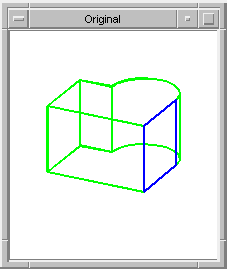 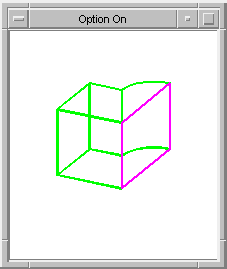 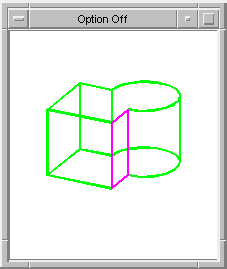
Figure. lop_prefer_same_convexity_sol |
[Top]
lop_repair_self_int
- Action
-
Controls whether or not self-intersections are repaired on the bodies
that result from local operations and shelling.
lop_repair_self_int is activated via an ACIS global option in versions R14 and earlier.
In versions R15 and later, see lop_options.
Name String-
lop_repair_self_int
Scheme-
| Type |
Values |
Default |
| boolean |
#f,#t |
#f |
C++-
| Type |
Values |
Default |
| logical |
FALSE,TRUE |
FALSE |
Description
This option controls whether or not self-intersections are repaired on
the bodies that result from local operations and shelling. If this option
is on, api_repair_body_self_ints
is called at the end of a successful local operation and supplied with
the changed body faces. It is therefore also called during shelling when
the LOP API api_offset_faces
is called.
If repairing self-intersections is required, option lop_check_invert
must be turned off, so that the elementary LOP self-intersection checks
are disabled and the operation produces a possibly invalid body to pass
to API api_repair_body_self_ints.
; lop_repair_self_int
; Repair self-intersections during a local operation
; Create a block
; Make sure the option is off
(option:set "lop_repair_self_int" #f)
;; #f
(define b1 (solid:block (position -25 -25 -25)
(position 25 25 25)))
;; b1
; Create a cylinder
(define b2 (solid:cylinder (position 0 0 -25)
(position 0 0 25) 10))
;; b2
; Subtract the cylinder from the block
(solid:subtract b1 b2)
;; #[entity 2 1]
; OUTPUT Original
; Turn off the lop_check_invert option
(option:set "lop_check_invert" #f)
;; #t
(lop:move-faces (pick:face (ray (position 0 0 0)
(gvector 1 0 0)) 1) (gvector 25 0 0))
;; #[entity 2 1]
; OUTPUT Option Off
; Roll back one step
(roll)
;; -1
(option:set "lop_repair_self_int" #t)
;; #f
; Make a self-intersecting body with
; self-intersecting faces
(lop:move-faces (pick:face (ray (position 0 0 0)
(gvector 1 0 0)) 1) (gvector 25 0 0))
;; #[entity 2 1]
; OUTPUT Option On
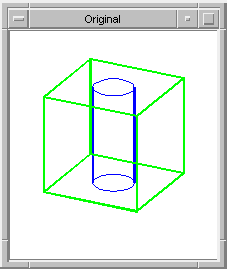 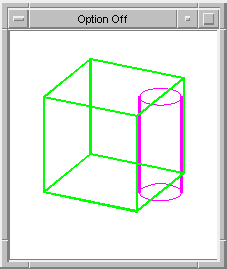 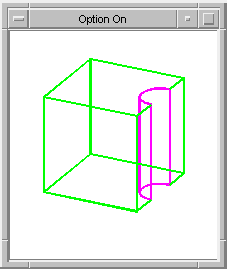
Figure. lop_repair_self_int |
[Top]
lop_sort_on_convexity
- Action
-
Controls whether sorting of solutions proceeds on convexity and then
distance or on distance and then on convexity.
Name String-
lop_sort_on_convexity
Scheme-
| Type |
Values |
Default |
| boolean |
#f,#t |
#t |
C++-
| Type |
Values |
Default |
| logical |
FALSE,TRUE |
TRUE |
Description
When there are multiple solutions for an edge during a local operation,
the tweak algorithm's default behavior is to first try to match the new
edge convexity as closely as possible with the old edge convexity. If
there are still multiple solutions after this initial pruning, the algorithm
chooses the edge solution that is closest to the original as measured
with a Euclidean distance at three points along the original and new edges.
This option allows the user to modify this default behavior. Because
the tweak algorithm is the basis for every local operation (and shelling),
this option modifies the behavior of all the local operations, not just
tweak.
If this option is on (true), sorting is first done on convexity, and
then on distance. If the option is off (false), sorting is done on distance
first and then on convexity.
[Top]
lop_stack_limit
- Action
-
Controls how much recursion can be done in the LOP code.
Name String-
lop_stack_limit
Scheme-
| Type |
Values |
Default |
| integer |
>0 |
512 |
C++-
| Type |
Values |
Default |
| int |
>0 |
512 |
Description
This option limits how much recursion can be done in the LOP code in order
to prevent crashes due to stack overflows. The value given by the option
will relate to the machine and operating system being used. The range
of values for the option is any positive integer value. However, it is
not intended for the option to be set very low, because this will cause
many simple examples (such as the following one) to fail unnecessarily.
; lop_stack_limit
; This will work with the default stack limit
(option:set "lop_repair_self_int" #t)
;; #f
(define b1 (solid:block (position -20 -20 -20)
(position 20 20 20)))
;; b1
(define cface (face:cone (position 0 0 0)
(position 0 30 0) 1 25 ))
;; cface
(lop:tweak-faces (pick:face (ray (position 19 19 19)
(gvector 0 1 0 ))) cface #f)
;; #[entity 11 1]
; Set the stack limit very low, and it fails
; unnecessarily
(option:set "lop_repair_self_int" #t)
;; #t
(option:set "lop_stack_limit" 6)
;; 512
(define b1 (solid:block (position -20 -20 -20)
(position 20 20 20)))
;; b1
(define cface (face:cone (position 0 0 0)
(position 0 30 0) 1 25 ))
;; cface
(lop:tweak-faces (pick:face (ray (position 19 19 19)
(gvector 0 1 0 ))) cface #f)
;; #[entity 14 1] |
[Top]
lop_use_euclidean_dist_score
- Action
-
Controls whether Euclidean or parametric distance is used when scoring
different solutions.
Name String-
lop_use_euclidean_dist_score
Scheme-
| Type |
Values |
Default |
| boolean |
#f,#t |
#t |
C++-
| Type |
Values |
Default |
| logical |
FALSE,TRUE |
TRUE |
Description
When there are multiple solutions for an edge during a local operation,
the tweak algorithm's default behavior is to first try to match the new
edge convexity as closely as possible with the old edge convexity. If
there are still multiple solutions after this initial pruning, the algorithm
chooses the edge solution that is closest to the original as measured
with a Euclidean distance at three points along the original and new edges.
This option allows the user to modify this default behavior. Because
the tweak algorithm is the basis for every local operation (and shelling),
this option modifies the behavior of all the local operations, not just
tweak.
If this option is on (true), Euclidean distance is used to score the
different possible solutions.
; lop_use_euclidean_dist_score
; This example shows tweak taking the nearer
; parametric solution, which is different for the
; closest solution measured with Euclidean distance.
(define plist(list (position 0 -8 0)
(position 0 0 0 ) (position 3 4 0)
(position 3.5 3.8 0) (position 6 0 0)
(position 5.5 -7.8 0) (position 5 -8 0)
(position 4.5 -7.8 0) (position 4 0 0)
(position 3.5 1.8 0) (position 3 2 0)
(position 2.5 1.8 0) (position 2 0 0)
(position 2 -8 0)))
;; plist
(define start(gvector 0 1 0))
;; start
(define end(gvector 0 -1 0))
;; end
(define path(edge:spline plist start end))
;; path
(define profile(edge:ellipse
(position 0 -8 0) (gvector 0 1 0).25))
;; profile
(define sweep(sweep:law profile path))
;; sweep
; Zoom to see the whole model
(zoom-all)
;; #[view 1076895352]
(define f (pick:face (ray (position 0 -7.8 0)
(gvector 0 -1 0))))
;; f
(define block (solid:block (position 0 2 -2)
(position 12 2.1 2)))
;; block
(entity:transform block (transform:rotation
(position 1 2 0) (gvector 0 0 1) -60))
;; #[entity 6 1]
(entity:fix-transform block)
;; #[entity 6 1]
(define t (car (pick:face (ray (position 1 1.9 0)
(gvector 0 1 0)))))
;; t
; Make sure that option is off
(option:set "lop_use_euclidean_dist_score" #f)
;; #t
(lop:tweak-faces f t #t)
;; #[entity 4 1] |
[Top]
© 1989-2007 Spatial Corp., a Dassault Systèmes company. All rights reserved.
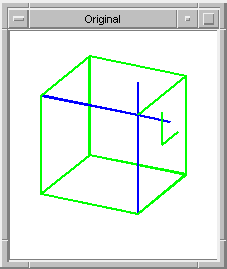
![]()
